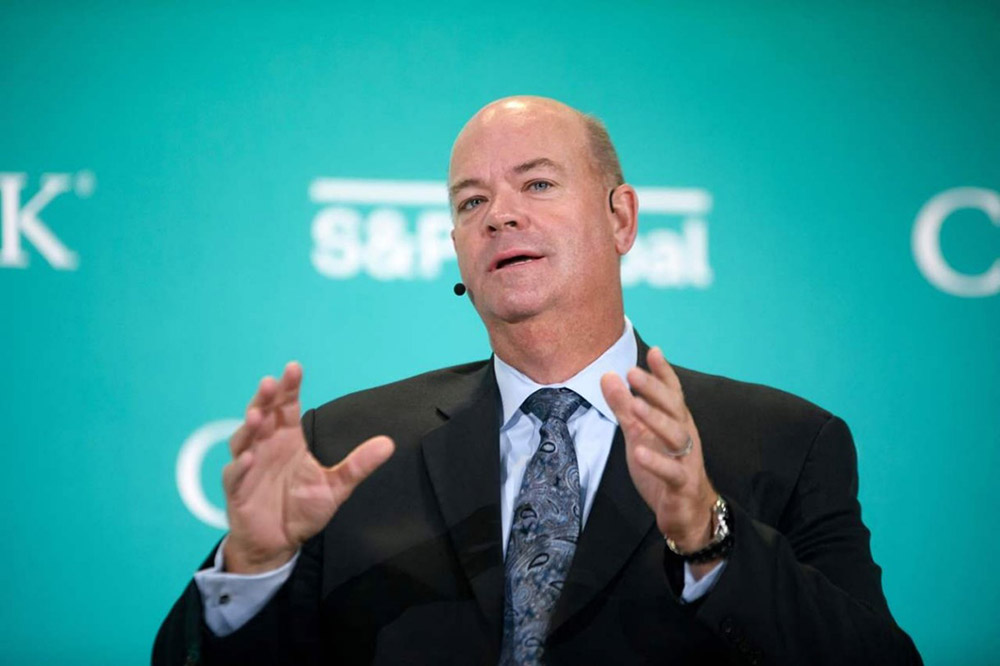
在关税压力与原油价格低迷的双重挑战下,康菲石油公司与其他美国石油生产商正着手削减成本。不过,现阶段他们仅采取适度的成本削减策略,以此维系运营灵活性,同时避免流失大量经验丰富的钻井及水力压裂作业人员。
美国最大的独立油气生产商康菲石油公司5月8日表示,将2025年资本支出削减3.5%,降至124.5亿美元的中点指导值,即缩减4.5亿美元。这与本周公布财报的其他主要石油生产商将资本支出削减2.5%到10%不等的做法不谋而合。
关税壁垒叠加石油输出国组织(OPEC)增产导致油价下跌,实际上已使石油行业陷入停滞,这与整体经济形势如出一辙。通常情况下,油价会跟随经济信号波动,原因是全球购买力减弱意味着出行减少,从而导致石油及燃料需求下降。
石油公司的首席执行官们几乎一致表示,由于存在诸多不确定性,他们希望保留在油价回升时重启钻井作业的能力;若油价持续低迷,他们则计划等到今年下半年再进一步削减开支。
康菲石油公司董事长兼首席执行官瑞安·兰斯(Ryan Lance)在财报电话会议上表示:“当前油价底部位置与筑底周期均难以预判。我们正着眼长远,打一场持久战。”
5月8日,美国基准油价略低于每桶60美元的关键阈值。兰斯认为,油价处于这一水平并不足以促使公司采取重大调整举措。通常情况下,企业将每桶65美元视为相对健康的油价标准,而当油价低于每桶60美元时,便会着手削减开支。
兰斯说:“目前应克制过激行动。既不能反应过激,也不应逃避现实。”
康菲石油公司在去年11月完成了对马拉松石油公司(Marathon Oil)高达225亿美元的巨额收购,除了适度削减开支外,其当前计划基本保持不变。这包括尽管资本支出和运营支出有所压缩,但仍维持此前设定的石油产量目标。
康菲石油公司的削减措施主要集中在推迟部分业务的临时支出,这些业务不会对2025年的油气产量造成影响。他表示,若未来数月油价进一步下跌,康菲石油公司和其他公司可能会进一步削减支出并缩减业务活动规模。
其他企业也纷纷采取行动:阿帕奇公司(Apache)计划将资本支出缩减6%,并持续出售非核心资产;戴文能源公司(Devon Energy)计划将资本支出缩减2.6%;二叠纪资源公司(Permian Resources)计划将资本支出缩减2.5%;响尾蛇能源公司(Diamondback Energy)宣布大幅削减10%的资本支出。
刚完成对Double Eagle和Endeavor Energy Resources收购(两笔重大收购)的响尾蛇能源公司还声称,整个行业的资本支出收缩表明“美国陆上石油产量或已触顶,并将在本季度开启下行通道”。
生机迹象
这种潜在的峰值以及持续存在的经济和关税不确定性在很大程度上使整个行业陷入停滞,各公司都在观望事态的发展。这在很大程度上意味着潜在并购以及其他关键战略决策均被推迟了。
不过,行业迎来新动态:自4月初特朗普总统加征关税以来,石油领域出现首笔超5亿美元的重大收购。但此次交易属于油气田资产范畴,并非企业并购。
二叠纪资源公司表示,将以6.08亿美元收购阿帕奇公司位于新墨西哥州二叠纪盆地特拉华北部区域超1.3万英亩(约合52.6平方千米)净面积油气资产。
二叠纪资源公司联合首席执行官威尔·希基(Will Hickey)在5月8日的财报电话会议上表示:“我们制定的战略是在任何市场环境下都主动出击。”
希基补充道:“新纳入的资产从交易完成首日起,便展现出资本吸引力。”
同样,去年秋天,二叠纪资源公司斥资8.2亿美元,完成对西方石油公司位于得克萨斯州特拉华南部资产的收购。在这两笔交易中,阿帕奇公司和西方石油公司所售地块均属其二叠纪盆地核心业务范围之外的“非核心”资产。另一方面,二叠纪资源公司专注于二叠纪盆地西部的特拉华地区业务。
Enverus Intelligence Research公司首席分析师安德鲁·迪特马(Andrew Dittmar)表示,这笔规模相对较小的交易契合双方战略需求,但它只是个例,并不足以预示交易和业务将回归常态。
他分析称,阿帕奇公司有意出售部分资产,而二叠纪资源公司则致力于扩张,尤其是在折价交易的情况下。
他解释道,通常情况下,企业若非必要都不愿出售优质钻井资源,潜在买家也不愿在经济低迷时期背负过多债务,导致并购市场持续承压。
迪特马说:“每家公司都力求在经济下行周期中找准自身定位。”(财富中文网)
译者:中慧言-王芳
在关税压力与原油价格低迷的双重挑战下,康菲石油公司与其他美国石油生产商正着手削减成本。不过,现阶段他们仅采取适度的成本削减策略,以此维系运营灵活性,同时避免流失大量经验丰富的钻井及水力压裂作业人员。
美国最大的独立油气生产商康菲石油公司5月8日表示,将2025年资本支出削减3.5%,降至124.5亿美元的中点指导值,即缩减4.5亿美元。这与本周公布财报的其他主要石油生产商将资本支出削减2.5%到10%不等的做法不谋而合。
关税壁垒叠加石油输出国组织(OPEC)增产导致油价下跌,实际上已使石油行业陷入停滞,这与整体经济形势如出一辙。通常情况下,油价会跟随经济信号波动,原因是全球购买力减弱意味着出行减少,从而导致石油及燃料需求下降。
石油公司的首席执行官们几乎一致表示,由于存在诸多不确定性,他们希望保留在油价回升时重启钻井作业的能力;若油价持续低迷,他们则计划等到今年下半年再进一步削减开支。
康菲石油公司董事长兼首席执行官瑞安·兰斯(Ryan Lance)在财报电话会议上表示:“当前油价底部位置与筑底周期均难以预判。我们正着眼长远,打一场持久战。”
5月8日,美国基准油价略低于每桶60美元的关键阈值。兰斯认为,油价处于这一水平并不足以促使公司采取重大调整举措。通常情况下,企业将每桶65美元视为相对健康的油价标准,而当油价低于每桶60美元时,便会着手削减开支。
兰斯说:“目前应克制过激行动。既不能反应过激,也不应逃避现实。”
康菲石油公司在去年11月完成了对马拉松石油公司(Marathon Oil)高达225亿美元的巨额收购,除了适度削减开支外,其当前计划基本保持不变。这包括尽管资本支出和运营支出有所压缩,但仍维持此前设定的石油产量目标。
康菲石油公司的削减措施主要集中在推迟部分业务的临时支出,这些业务不会对2025年的油气产量造成影响。他表示,若未来数月油价进一步下跌,康菲石油公司和其他公司可能会进一步削减支出并缩减业务活动规模。
其他企业也纷纷采取行动:阿帕奇公司(Apache)计划将资本支出缩减6%,并持续出售非核心资产;戴文能源公司(Devon Energy)计划将资本支出缩减2.6%;二叠纪资源公司(Permian Resources)计划将资本支出缩减2.5%;响尾蛇能源公司(Diamondback Energy)宣布大幅削减10%的资本支出。
刚完成对Double Eagle和Endeavor Energy Resources收购(两笔重大收购)的响尾蛇能源公司还声称,整个行业的资本支出收缩表明“美国陆上石油产量或已触顶,并将在本季度开启下行通道”。
生机迹象
这种潜在的峰值以及持续存在的经济和关税不确定性在很大程度上使整个行业陷入停滞,各公司都在观望事态的发展。这在很大程度上意味着潜在并购以及其他关键战略决策均被推迟了。
不过,行业迎来新动态:自4月初特朗普总统加征关税以来,石油领域出现首笔超5亿美元的重大收购。但此次交易属于油气田资产范畴,并非企业并购。
二叠纪资源公司表示,将以6.08亿美元收购阿帕奇公司位于新墨西哥州二叠纪盆地特拉华北部区域超1.3万英亩(约合52.6平方千米)净面积油气资产。
二叠纪资源公司联合首席执行官威尔·希基(Will Hickey)在5月8日的财报电话会议上表示:“我们制定的战略是在任何市场环境下都主动出击。”
希基补充道:“新纳入的资产从交易完成首日起,便展现出资本吸引力。”
同样,去年秋天,二叠纪资源公司斥资8.2亿美元,完成对西方石油公司位于得克萨斯州特拉华南部资产的收购。在这两笔交易中,阿帕奇公司和西方石油公司所售地块均属其二叠纪盆地核心业务范围之外的“非核心”资产。另一方面,二叠纪资源公司专注于二叠纪盆地西部的特拉华地区业务。
Enverus Intelligence Research公司首席分析师安德鲁·迪特马(Andrew Dittmar)表示,这笔规模相对较小的交易契合双方战略需求,但它只是个例,并不足以预示交易和业务将回归常态。
他分析称,阿帕奇公司有意出售部分资产,而二叠纪资源公司则致力于扩张,尤其是在折价交易的情况下。
他解释道,通常情况下,企业若非必要都不愿出售优质钻井资源,潜在买家也不愿在经济低迷时期背负过多债务,导致并购市场持续承压。
迪特马说:“每家公司都力求在经济下行周期中找准自身定位。”(财富中文网)
译者:中慧言-王芳
ConocoPhillips and other U.S. oil producers are cutting back costs amid tariff woes and weak crude prices, but they’re only making modest reductions for now to maintain flexibility and to avoid losing too many of their experienced drilling and fracking crews.
ConocoPhillips, the largest independent oil and gas producer in the U.S., said May 8 it would cut its 2025 capital expenditures by 3.5% down to a midpoint guidance of $12.45 billion—a reduction of $450 million. That meshes with other key oil producers reporting their earnings this week that cut capex anywhere from 2.5% to 10%.
The tariffs, along with lower oil prices from OPEC ramping up production, have essentially put a freeze on the oil industry that resembles the broader economy. Typically, oil prices follow economic signals because weaker global buying power means less travel and, therefore, less oil and fuel demand.
The oil CEOs are almost uniformly saying—because there is so much uncertainty—that they want to keep the ability to ramp drilling activity back up if prices recover and to wait until the back half of the year to make further cuts if the slump continues.
“The ultimate depth and duration of this current price environment remains unclear,” said ConocoPhillips chairman and CEO Ryan Lance in the earnings call. “We are playing the long game.”
While the U.S. benchmark for oil prices was sitting just below the notable $60 per barrel threshold on May 8, Lance argued that $60 doesn’t warrant big changes. Generally, companies consider anything above $65 relatively healthy, but they scale back below $60.
“Don’t whipsaw this thing too hard right now,” Lance said. “Don’t overreact, but don’t put your head in the sand either.”
ConocoPhillips, which closed the massive, $22.5 billion acquisition of Marathon Oil in November, is maintaining its current plans apart from the moderate spending cuts. That includes keeping its previous oil production guidance intact despite lower capex and operational spending.
Conoco’s cuts are focused on temporary spending deferrals on aspects of the business that do not impact oil and gas production in 2025. If oil prices drop further in the coming months, Conoco and others likely would make further reductions in spending and activity, he said.
Elsewhere, Apache said it is cutting capex by 6% and continuing to sell non-core assets; Devon Energy sliced capex by 2.6%; Permian Resources by 2.5%; and Diamondback Energy announced a larger 10% reduction.
Diamondback, which is coming off big acquisitions of Double Eagle and Endeavor Energy Resources, also contended that the overall industry cutbacks indicate “it is likely that U.S. onshore oil production has peaked and will begin to decline this quarter.”
Proof of life
That potential peak and the ongoing economic and tariff uncertainty has largely held the industry to a standstill as companies wait to see how things unfold. That has largely meant delays of potential mergers and acquisitions, as well as any other key strategic decisions.
One new development though is the first notable acquisition above $500 million announced in the oil industry since President Trump’s tariffs in early April. However, it’s an acreage deal and not a corporate acquisition.
Permian Resources said it would acquire more than 13,000 net acres in the Permian Basin’s northern Delaware lobe in New Mexico for $608 million from Apache.
“We build a strategy of trying to play offense in any environment,” said Permian Resources co-CEO Will Hickey during the May 8 earnings call.
“This newly acquired inventory competes for capital from day one,” Hickey added.
Similarly, Permian Resources paid $820 million last fall for acreage in the southern Delaware in Texas from Occidental Petroleum. In both cases, Apache and Oxy were selling acreage considered “non-core” to their primary Permian Basin positions. On the other hand, Permian Resources focuses exclusively on the Delaware portion in the western Permian.
Andrew Dittmar, principal analyst for Enverus Intelligence Research, said this relatively smaller deal makes sense for both companies, but it’s more of an outlier and does not represent any return to dealmaking and business as usual.
Apache was looking to sell some acreage, while Permian Resources is dedicated to growth, especially at a discount, Dittmar said.
In general, companies don’t want to sell valuable drilling inventory unless they need to, and potential buyers don’t want to add much debt in a weaker environment, he said. That makes mergers and acquisitions much harder to come by.
“Every company wants to position themselves well going into the downturn,” Dittmar said.






